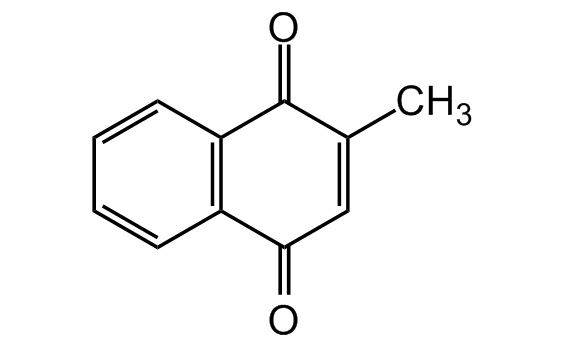
Chemical Structure
Menadione [58-27-5]

AG-CR1-3631
CAS Number58-27-5
Product group Chemicals
Estimated Purity>98%
Molecular Weight172.2
Overview
- SupplierAdipoGen Life Sciences
- Product NameMenadione [58-27-5]
- Delivery Days Customer10
- CAS Number58-27-5
- CertificationResearch Use Only
- Estimated Purity>98%
- Hazard InformationNon-hazardous,Warning
- Molecular FormulaC11H8O2
- Molecular Weight172.2
- Scientific DescriptionChemical. CAS: 58-27-5. Formula: C11H8O2. MW: 172.2. Synthetic naphthoquinone without the isoprenoid side chain and biological activity, but can be converted to active vitamin K2 (menaquinone) after alkylation in vivo. The 1,4-naphthoquinone (NQ) moiety can form redox isomers by accepting one or two electrons respectively. The quinone redox cycling ability leads to the generation of reactive oxygen species (ROS) as well as arylation reactions. Anticancer compound. Apoptosis inducer in various cultured cells including leukemia through several modes of action. Free radical generator. Produces peroxide and superoxide radicals (ROS) leading to mitochondrial dysfunction. Cell cycle inhibitor. Glutathione (GSH) depletion results by direct arylation of cellular thiols. Once GSH is depleted, cellular macromolecules start to be alkylated, resulting in their inactivation. Protein tyrosine phosphatase inhibitor. Inhibitor of mitochondrial DNA polymerase gamma. Inhibitor of indoleamine 2,3-dioxygenase (IDO) with an IC50 of ~1microM. - Synthetic naphthoquinone without the isoprenoid side chain and biological activity, but can be converted to active vitamin K2 (menaquinone) after alkylation in vivo. The 1,4-naphthoquinone (NQ) moiety can form redox isomers by accepting one or two electrons respectively. The quinone redox cycling ability leads to the generation of reactive oxygen species (ROS) as well as arylation reactions. Anticancer compound. Apoptosis inducer in various cultured cells including leukemia through several modes of action. Free radical generator. Produces peroxide and superoxide radicals (ROS) leading to mitochondrial dysfunction. Cell cycle inhibitor. Glutathione (GSH) depletion results by direct arylation of cellular thiols. Once GSH is depleted, cellular macromolecules start to be alkylated, resulting in their inactivation. Protein tyrosine phosphatase inhibitor. Inhibitor of mitochondrial DNA polymerase gamma. Inhibitor of indoleamine 2,3-dioxygenase (IDO) with an IC50 of ~1microM.
- SMILESO=C1C(C)=CC(C2=C1C=CC=C2)=O
- Storage Instruction2°C to 8°C,-20°C
- UNSPSC12352200
References
- Vitamin K3 induces cell cycle arrest and cell death by inhibiting Cdc25 phosphatase: F.Y. Wu and T.P.; Eur. J. Cancer 35, 1388 (1999)
- Apoptosis-inducing activity of vitamin C and vitamin K: H. Sakagami, et al.; Cell Mol. Biol. 46, 129 (2000)
- Cytotoxic activity of vitamins K1, K2 and K3 against human oral tumor cell lines: H. Okayasu, et al.; Anticancer Res. 21, 2387 (2001)
- 2-Methyl-1,4-naphthoquinone, vitamin K(3), decreases gap-junctional intercellular communication via activation of the epidermal growth factor receptor/extracellular signal-regulated kinase cascade: L.O. Klotz, et al.; Cancer Res. 62, 4922 (2002)
- Signaling effects of menadione: from tyrosine phosphatase inactivation to connexin phosphorylation: K. Abdelmohsen, et al.; Methods Enzymol. 378, 258 (2004) (Review)
- Vitamin K3 (menadione)-induced oncosis associated with keratin 8 phosphorylation and histone H3 arylation: G.K. Scott, et al.; Mol. Pharmacol. 68, 606 (2005)
- Menadione-induced reactive oxygen species generation via redox cycling promotes apoptosis of murine pancreatic acinar cells: D.N. Criddle, et al.; J. Biol. Chem. 281, 40485 (2006)
- Activation of ErbB2 by 2-methyl-1,4-naphthoquinone (menadione) in human keratinocytes: role of EGFR and protein tyrosine phosphatises: J.I. Beier, et al.; FEBS Lett. 580, 1859 (2006)
- Inhibition of PTEN and activation of Akt by menadione: K. Yoshikawa, et al.; Biochim. Biophys. Acta 1770, 687 (2007)
- Indoleamine 2,3-Dioxygenase Is the Anticancer Target for a Novel Series of Potent Naphthoquinone-Based Inhibitors: S. Kumar, et al.; J. Med. Chem. 51, 1706 (2008)
